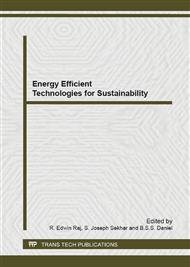[1]
Bukolo O. Bolajia, 2006. Flow design and collector performance of a natural circulation solar water heater, Journal of Engineering and Applied sciences 1(1) pp.7-13.
Google Scholar
[2]
Fanny, A.H. and S.A. Klein, 1998. Thermal performance comparisons for solar hot water systems subjected to various collector and heat exchanger flow rate, Solar Energy, pp.1-11.
DOI: 10.1016/0038-092x(88)90065-5
Google Scholar
[3]
Rai. G.D. 2005 Solar Energy Utilization, Khanna Publishers. pp.102-104 and 135-145.
Google Scholar
[4]
Saidur. R, Leong.K. L, Mohammad H.A. 2011, A review on applications and challenges of nanofluids, Renewable and sustainable Energy Reviews, 15, pp.1646-1668.
DOI: 10.1016/j.rser.2010.11.035
Google Scholar
[5]
P. Sivakumar, W. Christ Raj, M. Sridharan and N. Jaya Malathi, 2012, Performance improvement study of solar water heating system, Journal of Engineering and Applied Sciences, January, Vol. 7 No. 1, pp.45-49.
Google Scholar
[6]
Soteris A. Kalogirou 2004 Solar thermal collectors and applications Progress, Energy and Combustion Sciences, 30, p.231–295.
DOI: 10.1016/j.pecs.2004.02.001
Google Scholar
[7]
S.P. Sukhatme. and J.K. Nayak 2008 Soar Energy, Principles of Thermal Collection and Storage, Tata McGraw Hill Education Private Limited, pp.109-158.
Google Scholar
[8]
G.N. Tiwari. and Jamil Ahmed, 2009 Optimization of tilt angle for solar collector to receive maximum radiation, The open Renewable Energy journal, pp.19-24.
DOI: 10.2174/1876387100902010019
Google Scholar
[9]
Tooraj yousefi , Farzad veysi , Ehsan Shojaeizadeh , Sirus Zinadini 2012, An Experimental investigation on the effect of Al2O3 –H2O nanofluid on the efficiency of the Solar flat plate collectors, Renewable Energy, (39) pp.293-298.
DOI: 10.1016/j.renene.2011.08.056
Google Scholar
[10]
Tooraj yousefi , Farzad veysi , Ehsan Shojaeizadeh , Sirus Zinadini 2012- An experimental investigation on the effect of MWCNT- H2O nanofluid on the efficiency of flat plate solar collectors, Experimental Thermal and Fluid Science, (39) pp.207-212.
DOI: 10.1016/j.expthermflusci.2012.01.025
Google Scholar
[11]
Volker Weitbrecht, David Lehmann and Andreas Richter , 2002 Flow Distribution Solar Collectors With Laminar Flow conditions, Solar Energy Vol. 73, No. 6, p.433–44.
DOI: 10.1016/s0038-092x(03)00006-9
Google Scholar
[12]
Vijay S. Raykar, Ashok K Singh. 2010 Dispersibility dependence of thermal conductivity of carbon nanotube based nanofluids, Physics Letters A , (374) pp.4618-4621.
DOI: 10.1016/j.physleta.2010.09.032
Google Scholar
[13]
T. Yousefi .E. Shojaeizadeh, F. Veysi, S. Zinadini 2011 An experimental investigation of pH variation of MWCNT- H2O nanofluid on the efficiency of the flat- plate solar collector, Solar Energy, 86, pp.771-779.
DOI: 10.1016/j.solener.2011.12.003
Google Scholar
[14]
Wei yu, Huaqing Xie, Yang Li, Lifei Chen, 2011, Experimental investigation on thermal conductivity and viscosity of aluminum nitride nanofluid, Particulogy, 9, pp.187-191.
DOI: 10.1016/j.partic.2010.05.014
Google Scholar


